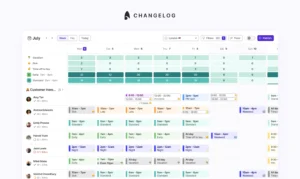
A guide to workforce management in call centres

Imagine your customers waiting endlessly to talk to your agent, and when they eventually do, the agent knows nothing about their issue. It’s a scenario that no business wants, yet it’s all too common in today’s world.
But let’s not just leave it to the imagination; let’s pull back the curtain and understand what actually happens behind the scenes.
Your call centre agents juggle fluctuating call volumes, struggling to get the right person on the call while maintaining low wait times and tracking customer queries.
All this chaos stems from one common issue – poor workforce management.
In this blog, we will discuss the significance of effective workforce management and its impact on your company’s customer experience. We will also share how you can get started with workforce management in your call centre.
Why do call centres need workforce management?
Before we share insights on how you can get started with call centre workforce management, let’s understand how workforce management helps in a call centre.
1. Improved customer experience
The Harvard Business Review article aptly states that happy employees are the key to happy customers.
A well-managed workforce has balanced work on their plates, which boosts your customer experience with shorter wait times, faster issue resolution, and personalised service. This directly translates into higher Customer Satisfaction (CSAT) scores.
Workforce management also increases the probability of Service Level Agreements (SLAs) being met, further strengthening the company’s reputation and customer loyalty.
2. Cost savings
Structured workforce management helps manage staffing levels, reduce overstaffing during slow periods, and minimise understaffing during peak hours. This balanced approach can save significant costs by eliminating unnecessary labour expenses.
Properly managing agent schedules and shifts also cut down the need for overtime. Overtime pay typically involves higher hourly rates, which significantly increase labour costs.
Here, implementing scheduling tools like Surfboard can be beneficial. Surfboard’s intuitive shift planning feature can help you plan ahead of high demands. Thus, you can plan your resources better to avoid overstaffing or understaffing.
3. Agile response to changes
Customer demand may fluctuate rapidly in response to various factors, such as seasonal trends or unexpected events. Workforce management allows call centres to adapt quickly by adjusting staffing levels, skills allocation, and scheduling to meet these changing demands while maintaining service quality.
4. Scalability
Call centres must scale as businesses grow to cater to the growing customer base. Proper workforce management offers you the flexibility to add or reduce staff smoothly while ensuring the organisation meets customer needs without delays or extra costs.
Key components of call centre workforce management
You can’t reap the above-mentioned benefits overnight. Workforce management involves going through four important steps, which are listed below.
1. Forecasting
Forecasting is the foundation of workforce management in call centres. It involves predicting and planning for future call volumes, customer interactions, and service demand.
Accurate forecasting relies on the following:
- Historical data analysis – examine past data to understand patterns, relationships, and behaviours.
- Seasonality patterns – recognise recurring patterns that happen at specific times of the year, such as holidays, seasons, or business cycles.
- Identifying trends – spot consistent, long-term shifts or data movements, whether they are upward or downward trends.
Consider the above factors to estimate call volumes, ensuring wise resource allocation. For example, if historical data indicates a surge in calls during the Black Friday season, the call centre can adjust staffing levels accordingly to meet the increased demand without overstaffing during lean periods.
2. Employee scheduling
85% of workers’ schedules are often changed at the last minute. This is one thing you must work towards.
Once forecasting is done, call centres must create schedules for employees to align with the predicted demand. This involves assigning shifts, break times, and days off to optimise the agent coverage while considering labour regulations and employee preferences. Proper scheduling considers agent skills and capabilities, ensuring that the right people with suitable skill sets are available to answer specific customer queries.
3. Agent assigning & staffing
Staffing involves allocating agents to different queues, campaigns, or channels within the call centre.
This step considers factors such as – agent availability, skills, expertise, and preferences. For example, if there is a surge in technical support calls, staffing would involve assigning agents with technical expertise to address these queries promptly.
If there’s a lack of technical agents, consider hiring more or reshuffling the existing structure to meet the demand. Figure out the number of agents you need in your call centre using an Erlang calculator.
Proper agent assigning ensures that customers receive accurate and tailored service while ensuring agent engagement and skills utilisation.
4. Intraday management
Intraday management focuses on making real-time adjustments to schedules and staffing throughout the day to respond to unexpected changes in call volume.
It involves monitoring the call centre’s performance in real time and deploying additional resources when call queues start to build up or scaling back when the demand decreases. This helps maintain service level targets, minimise wait times for customers, and check if the capabilities of each agent are fully utilised, even in dynamic and unforeseen situations.
With Surfboard’s Slack integration, you can also notify employees of schedule changes instantly.
How to monitor the impact of workforce management?
After you have carried out all the above steps in workforce management, the next thing to do is assess whether you have achieved the desired result.
Some parts of the evaluation require daily reporting, whereas others may require a month-on-month (MoM) or quarter-on-quarter(QoQ) assessment. This evaluation phase is important to inform future workforce management strategies.
Here’s how to approach this assessment:
1. Review KPIs & metrics
Begin by revisiting the call centre workforce management metrics and KPIs you defined at the beginning. Compare the current data with your baseline measurements to figure out whether there have been improvements or areas that still need attention.
You may also look for trends and patterns in the data. Ask the following questions:
- Have certain KPIs consistently improved, or have there been fluctuations?
- Are there specific periods where performance significantly changed?
Further, the following metrics may be taken into consideration to measure the impact:
- Schedule Adherence: Measure how well employees stick to their schedules. This is critical for ensuring timely service delivery. Surfboard’s time-on-task feature helps you gain insights into individual and team performance and their adherence to the schedules.
- Utilisation Rate: Assess how effectively your workforce is being utilised. Ensure that they are busy but not overwhelmed with workload.
- Turnover Rate: High turnover can indicate issues within your workforce management strategy. Tracking this metric is essential for retention efforts.
2. Reporting dashboards & tools
Begin using reporting tools and dashboards to visualise and understand the workforce management data. These tools make it easier to spot trends and areas that require attention.
Investing in call centre workforce management software is a good idea. These tools help in monitoring and fine-tuning workforce activities by equipping you with real-time data and analytics.
With real-time data at your fingertips, you can effortlessly track KPIs, ensure schedule adherence, and analyse various metrics to see the current progress of your workforce. Best workforce management software helps you with workforce planning, time and attendance tracking, workforce analytics, and employee scheduling.
3. Gather employee feedback
Gathering employee and team feedback is one of the most crucial steps in monitoring the outcome. In fact, companies that conduct regular feedback experience 14.9% lower turnover rates.
- Conduct employee surveys.
- Encourage anonymous feedback to ensure employees feel comfortable sharing their honest opinions.
- One-on-one meetings or group discussions can also help understand your employees’ POV.
- Implement an employee suggestion box or portal where employees can submit ideas and feedback anytime.
Review and act on your employees’ feedback to foster a culture of continuous improvement.
How Surfboard simplifies call centre workforce management in 2023?
Today, about 49% of call centres prioritise employee satisfaction. Call centres are moving away from their traditional North Star metric of customer satisfaction, realising that they can no longer achieve it at the expense of burnt-out agents.
Translation: Happy and engaged agents are key to delivering exceptional customer experiences.
Find the right balance between customer service excellence and employee well-being with tools like scheduling software.
Surfboard is one of the high-rated scheduling software that helps you create logical agent schedules that meet your service level agreements (SLAs) without sacrificing the happiness of your team.
It offers integrated forecasting and reporting capabilities to help you predict call volume and identify areas where you need to make adjustments to the agent schedule. Surfboard also makes it easy to create flexible schedules that take into account agent availability, skills, and preferences.
With Surfboard, you can be confident of soaring CSAT scores and reduced costs.
Book a demo to explore Surfboard features.
💡 Want to learn more about Surfboard?
Check out how Surfboard helped Klaus streamline its scheduling and enhance customer interactions with intraday scheduling, shift planning, time-on-task, and forecasting.
FAQs
What is the role of a call centre workforce management manager?
A call centre workforce management manager oversees the scheduling, staffing, and optimisation of a call centre’s resources. They ensure that the right number of agents with appropriate skills are available to handle customer inquiries while maintaining service quality.
Why is workforce management important in call centres?
Workforce management is essential in call centres because it helps balance resources and customer demand. It reduces wait times, improves issue resolution times, enhances customer satisfaction, and guarantees efficient use of resources, ultimately leading to cost savings and increased profitability. It also improves agent productivity and makes sure your business responds to changes in an agile manner.
What are the key responsibilities of a call centre workforce management manager?
Key responsibilities of a call centre workforce management manager include:
- Forecasting call volumes and workloads
- Creating optimised agent schedules
- Monitoring real-time call centre performance
- Adjusting staffing as needed
- Analysing data to improve efficiency
- Ensuring compliance with service-level agreements
- Providing ongoing training and development for agents
Can workforce management be applied to remote or distributed call centre teams?
Yes, workforce management can be applied to remote or distributed call centre teams. Advanced technology and cloud-based solutions enable managers to monitor and optimise remote agents’ performance, ensuring consistent service quality and efficiency regardless of agents’ locations.



